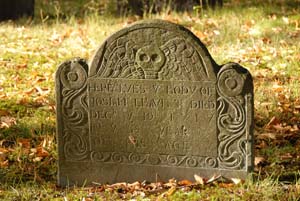Choosing a Grave Marker
 Grave markers - otherwise known as gravestones, tombstones or headstones - are used to indicate the location of the deceased. They are also focuses for mourning and remembrance. They are generally inscribed with the deceased's name, dates of birth and death, and a short epitaph, homily or observation. If other family members are later buried in the same plot, their names can be added to the stone.
Grave markers - otherwise known as gravestones, tombstones or headstones - are used to indicate the location of the deceased. They are also focuses for mourning and remembrance. They are generally inscribed with the deceased's name, dates of birth and death, and a short epitaph, homily or observation. If other family members are later buried in the same plot, their names can be added to the stone.Grave markers are found, most obviously, in cemeteries, but they can also be found in crematoria, where even though there's no physical body mourners can gather to remember their loved one, and inside churches and mausoleums which have the advantage of better protecting the stones or plaques from the elements. Cemeteries will have their own rules about what size, shape and material grave markers can be. These regulations can be determined by national codes of practice or a cemetery's situation in a conservation area, or by more practical concerns like the need to be able to mow the grass. The cemetery will either install the stone itself for a fee, or installation might be included in the services of the company who made the grave marker.
Most grave markers are carved from stone, with granite, marble and sandstone being the most popular options. Alternatively, a tree can be planted, for example, to mark the site of a loved one's ashes.
You will normally need to commission your loved one's grave marker from a monumental mason. This can sometimes be done online. The most common basic styles of grave marker are the traditional upright, slanted, and flat. These can be requested in smaller sizes for children or - with the addition of pawprints or other appropriate embellishments, pets. There are certain shapes that are also popular - the open book, for examples, or a cross. You can also get accessories like a vase or candle holder.
Many monumental masons will custom craft you a grave marker, so you could go for something more elaborate, a sculpture of an angel, say, or the Virgin Mary. Or you could get your own design drawn up to reflect the deceased's personality.
Another way to personalise your grave marker is with a picture. Masons can now etch the stone with a portrait of the deceased taken from a photo, or with some other image that has relevance to your loved one, perhaps a favourite hobby or flower. Or there's a whole range of simple images that have greater symbolic meaning. A horseshoe, for example, protects against evil; a dolphin bears the soul up to heaven; and a frog indicates an enjoyment of worldly pleasures.
An inscription can be a particularly telling expression of the deceased's personality or world view. A brief epitaph can sum up the special qualities of a loved one. Alternatively, if they were religious then a couple of well-chosen lines of scripture may be appropriate; if they were philosophical then a wise saying. If they had a good sense of humour then maybe they'd like to be sent off with a witty remark, like Spike Milligan's famous, "I told you I was ill". A grave marker can even be used politically. In January 2008 Matthew Prescott, an employee of PETA, had a grave marker installed in Cave Hill Cemetery, Louisville, Kentucky, ready for his eventual demise. It sits near the grave of KFC founder Harland Sanders and is inscribed with a acrostic poem that spells out "KFC tortures birds."
Having a grave marker made for yourself ready for your death is actually a good idea. Not only will it be made at today's prices, but you guarantee that you will be remembered in the style that you wish. Similarly, if you are buying a grave marker for a loved one, make sure it is an expression of their personality as they would wish it remembered, and of the love felt by friends and family towards them.
Memorial Resources
- Imorial Helps the Bereaved by Providing Free Online Memorials of Loved Ones
- Memory of Lost Loved Ones
- Create a Free Online Memorial
- Building Memories with imorial
- imorial: Where Life is Celebrated
- Healing From Grief
- Online Memorial Helps with Grief
- How to Write a Memorial Poem
- Memorial Poem by Emily Dickinson
- Memorial Poem by Judith Pordon
- Memorial Poem by Robert-Frost
- How to Write a Eulogy
- How to Write an Orbituary
- Why Choose Imorial?
- Writing a Tribute
- Writing a Special Obituary
- How to Create an Online Memorial
- Coping With Grief
- Crafting an Online Memorial
- Create an Everlasting Online Memorial
- Selecting Music for a Funeral
- Selecting Flowers for a Funeral
- Selecting a Funeral Poem
- How to Choose Funeral Readings
- Imorial now links online memorials to physical locations with QR codes
- How to Choose a Funeral Home
- Funeral Programs: The Memorial Service Bulletin
- Understanding the Cremation Process
- Choosing a Casket
- Choosing a Grave Marker
- Obituaries and Death Notices
- Funeral Checklist







